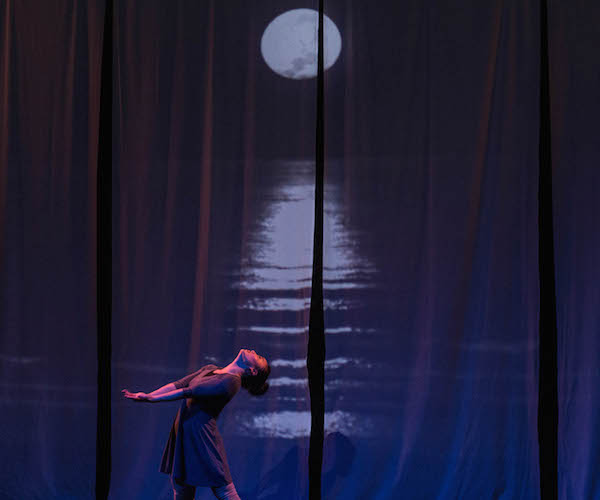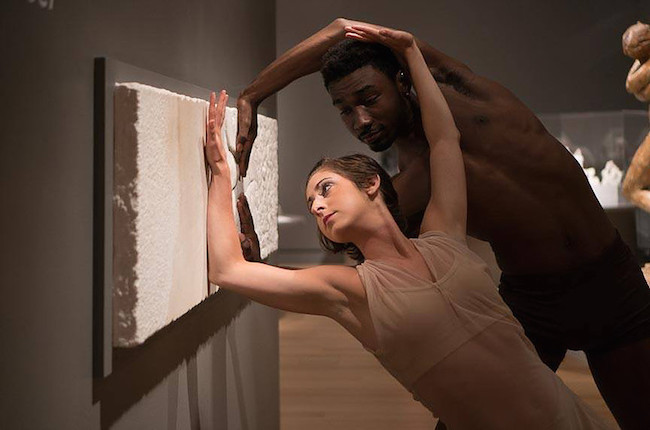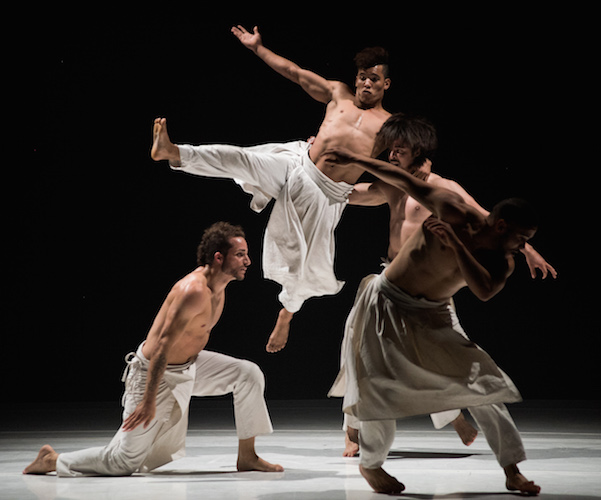Feature: Best in Dance of 2016
Fuse dance critics pick some of the outstanding performances/events of the year.
Roads Taken and Imagined

Paula Josa-Jones in a scene from “Of This Body.” Photo: courtesy of the artist.
There really isn’t anything “best” in art. Singling out any one artist or art work is to downgrade the hard work and good instincts of everything else. In the end there’s only what one person likes. The Boston events that stand out for me in 2016 are performances that seemed especially innovative, and those that looked at a range of things from the past.
One solo dancer, Paula Josa-Jones, multiplied herself into a village of not-quite human characters. Returning to the Dance Complex after several years away from the local scene, she didn’t do an extroverted return-of-the-star appearance. Instead, she seemed always to be in disguise under an assortment of odd but intriguing costume articles and props, on the brink of dissolving into a series of cinematic environments.
At the Institute of Contemporary Art, Yanira Castro‘s Court/Garden created a spectacle with minimal means: masks, paper, screens. Castro’s dancers tried to break down the separation between performers and audience, first by turning themselves into surrogates for the French monarchy, in little walking dances laced with Baroque hand and leg gestures recalling the court of Louis XIV. Their understated grandeur broke down in Part 2, where the same actors shrank to characters in a pretend puppet show and were videotaped in a backstage dressing room. Let loose in the dance space, the audience members were prompted to learn the dance steps and fix up their own costumes. In a chaotic but joyous assemblage, they themselves became the show.
Compangie Hervé Koubi, based in France, brought hip hop blended with Islamic motifs to the ICA in Ce que le jour doit à la nuit. Resisting the ego-driven, applause-invoking showiness of the usual hip hop performance, the all-male company worked together with a calm, almost meditative concentration. Instead of displaying tricks, they could have been using their superhuman turns and flips to levitate onto another plane of existence.
There can be nothing deader than dance history, until dancers reanimate the past. Boston Ballet seasoned its usual repertory of contemporary dance and Russian classics with “Kaleidoscope,” its March program of 20th century one-act ballets. George Balanchine’s Kammermusik No. 2, Leonid Yakobson’s neo-romantic remake of the Pas de Quatre, William Forsythe’s wry 1966 take on ballet formalism, The Vertiginous Thrill of Exactitude, and Leonide Massine’s 1938 tintype Gaîté Parisienne. The young dancers in Boston Ballet II and the BB school also worked on a range of styles in their performances of February and August.
2015 MacArthur Fellowship winner Michelle Dorrance didn’t appear in Boston this year, but the extraordinary tapper will be back at the Cutler Majestic Jan 13-15th. Something to look forward to in the trumphian days to come.
Internationally known writer, lecturer, and teacher Marcia B. Siegel covered dance for 16 years at The Boston Phoenix. She is a contributing editor for The Hudson Review. The fourth collection of Siegel’s reviews and essays, Mirrors and Scrims—The Life and Afterlife of Ballet, won the 2010 Selma Jeanne Cohen prize from the American Society for Aesthetics. Her other books include studies of Twyla Tharp, Doris Humphrey, and American choreography. From 1983 to 1996, Siegel was a member of the resident faculty of the Department of Performance Studies, Tisch School of the Arts, New York University.

Chun-Jou Tsai’s The Dream Project II: Luna Soul. Photo: Augusta Rose.
The Dream Project’s Luna Soul. Presented at the Multicultural Arts Center, Cambridge, MA, in March.
The Dream Project debuted its second performance to date, showcasing not only the physical talent of its performers, but the importance of its ongoing goal to merge East and West through dance. Inspired by the Eastern story of Xi Shi, yet personified through Western modern dance, the work successfully depicted Chinese traditional values as seen through the female perspective.
Yury Yanowsky’s Smoke and Mirrors. Performed by Boston Ballet at the Boston Opera House, Boston, MA, in May.
Boston Ballet’s spring performance Mirrors included the world premiere of Yury Yanowsky’s “Smoke and Mirrors.” A visual and choreographic masterpiece, “Smoke and Mirrors” began with slow, calculatingly pensive movements that later erupted into the riveting exploration of an ancient world — a world that was often evocative of our global, modern-day warfare. Beautifully executed by its performers, “Smoke and Mirrors” left the audience enthralled yet chilled.
Les 7 Doigts de la Main’s Cuisine & Confessions. Presented at the Cutler Majestic Theatre, Boston, MA, in August.
Easily the best production that stopped in Boston on tour in 2016, Cuisine & Confessions proffered a passionate, athletic, jaw-dropping performance that seamlessly merged circus, theatre, dance, and storytelling. It is rare that a performance has so immersed its audience in such a genuine, heartfelt manner—encouraging its viewers to chat freely with each other (entering as strangers, leaving as friendly neighbors). At the end of the show viewers enjoyed noshing on warm banana bread and freshly cooked pasta. It doesn’t get better than that!

“Rodin: Transforming Sculpture.” Photo: Mercer Photography.
Rodin: Transforming Sculpture with BoSoma Dance Company. Presented at the Peabody Essex Museum, Salem, MA, May through September.
BoSoma Dance Company’s long-term performance installation at the Peabody Essex Museum this past May through September generated buzz in both the dance community and visual arts scene. As part of the Rodin exhibition, the company presented a series of interactive performances that mingled dancers and sculpture. The approach gave viewers an intriguing chance to experience dance in a nontraditional setting.
Merli V. Guerra is a professional dancer with a background in ballet, modern, and classical Indian dance in the Odissi style, and an award-winning interdisciplinary artist with talents in choreography, filmmaking, installation art, and graphic design. She is co-founder and artistic director of Luminarium Dance Company; art director of Art New England magazine; Boston’s ballet and contemporary dance critic for the international Fjord Review; and selects The Arts Fuse’s weekly coming attractions for dance.
As ’tis the season when arts writers are asked for their “year in review” thoughts, mine are below; I should explain that my notes don’t involve Boston-area dancers/dance companies because I’ve been based in Western Massachusetts since 2003. But I’m first and foremost a Boston gal—born and bred in Chelsea!—and a good deal of my heart still belongs to Beantown. Lately my schedule rarely allows me the opportunity to see performances in the Boston area, but I thrill to hear about those performances, as well as upcoming projects, and the work in general that dancers and dancemakers are engaged in. Merde and warm wishes to all of you engaged in that work in 2017!
So what terpsichorean delights captivated me way out in the wild west of Massachusetts? It continues to seem a minor miracle to me that the Jacob’s Pillow Dance Festival, one of the most revered meccas of dance in the world, exists out here in my adopted neck of the woods. Do I have “favorite” performances each Pillow season—which runs from late June to late August—that I could put in some kind of rated list? Perhaps, but that feels a bit Grinchy to me this year (chalk it up to my End-of-the-World-as-We-Know-it induced melancholia, a condition I know I’m not the lone sufferer of), so instead, I’d like to convey my sincere gratitude to the whole Pillow staff, and the many exceptional artists who offered up such beauty over the course of the ten weeks. And indeed there were a number of quite wonderful performances that I’m happy to mention here, a few that I wrote about for The Arts Fuse, and others that I wrote about for other publications. Alas, I missed the two tap shows, Michelle Dorrance’s and Nicholas Van Young’s “ETM: Double Down,” and the Dormeshia Sumbry-Edwards/Derick K. Grant/Jason Samuels Smith collaboration “And Still You Must Swing.” According to other writers’ recent pieces—Joan Acocella in The New Yorker (about “ETM”) and Brian Seibert in The New York Times (“And Still” made it onto his year-end “best of dance” list)—it’s a shame I did!
(As it happens, the world-class contemporary art museum MASS MoCA also lives out in Western Mass., and it and the Pillow team up occasionally to present dance in the museum’s funky repurposed mill buildings. In April, ZviDance performed choreographer Zvi Gotheiner’s work-in-progress On the Road, an abstract danceramble inspired by Jack Kerouac’s road-trippy text; I haven’t yet seen the finished production (which premiered in early December at Brooklyn Academy of Music’s BAM Fisher) but the results sound promising. Alastair Macaulay wrote in The New York Times that it is “…a good—often wonderful—dance.”)
In any event, here, in chronological order, are many of the glories served up on the Pillow stages this past summer, with mini-descriptions borrowed from my reviews:
the eager, malleable, but palpably individual dancers of Aspen Santa Fe Ballet;
the dancing Argentine cowboys of Che Malambo, whose men dance with a power and passion that builds into a kind of ecstasy;

Giovanni Martinat, Mourad Messaoud, Amine Maamar Kouadri, and Nassim Hendi of Compagnie Hervé KOUBI in “What the Day Owes to the Night” (Ce que le jour doit à la nuit). Photo: Cherylynn Tsushima.
choreographer Soon-Ho Park’s Seoul-based Bereishit Dance Company, whose dancers, like Park’s choreography, reflect a deep seriousness and facility in their craft;
the exuberant, personable, immediate dancers of Gauthier Dance//Dance Company Theaterhaus Stuttgart;
the veteran Hubbard Street Dance Chicago’s excellent program, both dark and human, highlighted by the suspenseful playfulness of William Forsythe’s “N.N.N.N.” and Crystal Pite’s poetic, luminous “Solo Echo;”
Matthew Neenan’s earthy and sensual “Sunset, o639 Hours,” performed by the ten superb dancers of Neenan’s Philadelphia-based BalletX;
“Escher/Bacon/Rothko,” choreographer Zvi Gotheiner’s abstract take on those twentieth century masters and full of painterly images…but…gorgeous and sophisticated—not a paint-by-numbers affair;
Bryan Arias’ rather absurdist, wonderfully so “a rather lovely thing” performed by Arias and the three other terrific dancers of ARIAS Company;
the heartbreaking poetry of Antony Tudor’s 1937 masterpiece “Dark Elegies,” performed with sensitivity by members of the wonderful little New York Theatre Ballet, with Maya Oguri and Elena Zahlmann the standouts among the soloists, each exquisitely balancing Tudor’s consummate union of simplicity and drama;
the now velvety, ambient; now gripping, explosive movement of French-Algerian choreographer Hervé Koubi’s evocative “Ce que le jour doit à la nuit (What the Day Owes to the Night)”;
Adam H. Weinert’s “MONUMENT” project, featuring reconstructions of decades-old dances by Pillow founder Ted Shawn, as well as dances by two other modern dance icons, Doris Humphrey and José Limón. This quick modern dance history lesson was followed by a new ensemble piece created by Weinert and the six other dancers involved in the reconstruction process; the echoed bits of the earlier dances add to the evening’s overall sense that we are in some kind of lovely time warp;
Pam Tanowitz’s gloriously musical and thick with delightful eccentricities “Heaven On One’s Head,” is, like her other dances, perfumed with the past but steeped in the present;
the most elegant of hat tricks triple bill performed by the mighty Pacific Northwest Ballet; on opening night the company glowed with its full, formidable luster, the performers expansive, their clean technique articulate yet relaxed.
That line-up was the last curated by the Pillow’s longtime executive and artistic director, Ella Baff, who has moved on after her seventeen impressive years at the helm. Her successor, Pamela Tatge, was a warm and gentle hostess throughout last year’s Festival; this year’s line-up, which was announced several weeks back, is thus Tatge’s first: It looks smashing.
Janine Parker can be reached at parkerzab@hotmail.com.
